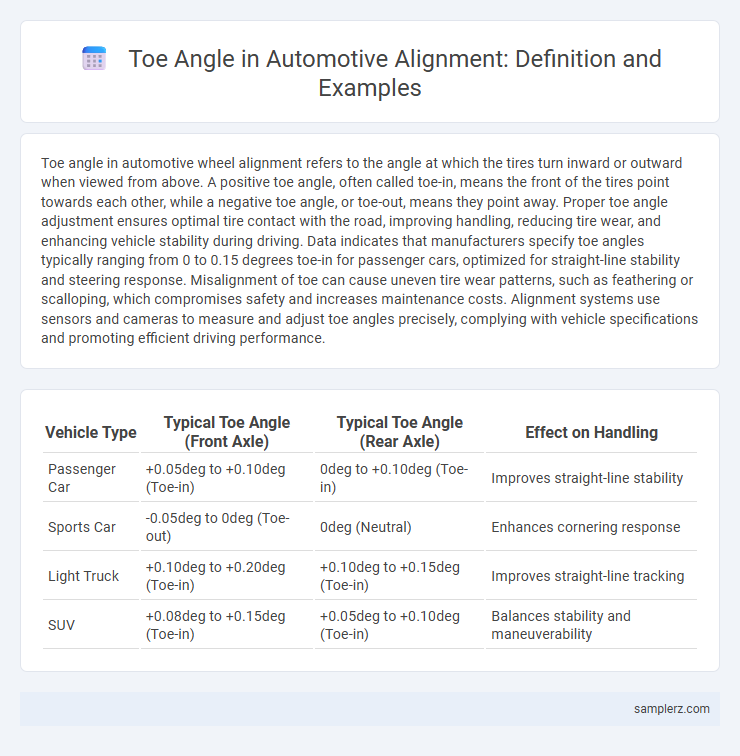Toe angle in automotive wheel alignment refers to the angle at which the tires turn inward or outward when viewed from above. A positive toe angle, often called toe-in, means the front of the tires point towards each other, while a negative toe angle, or toe-out, means they point away. Proper toe angle adjustment ensures optimal tire contact with the road, improving handling, reducing tire wear, and enhancing vehicle stability during driving. Data indicates that manufacturers specify toe angles typically ranging from 0 to 0.15 degrees toe-in for passenger cars, optimized for straight-line stability and steering response. Misalignment of toe can cause uneven tire wear patterns, such as feathering or scalloping, which compromises safety and increases maintenance costs. Alignment systems use sensors and cameras to measure and adjust toe angles precisely, complying with vehicle specifications and promoting efficient driving performance.
Table of Comparison
| Vehicle Type | Typical Toe Angle (Front Axle) | Typical Toe Angle (Rear Axle) | Effect on Handling |
|---|---|---|---|
| Passenger Car | +0.05deg to +0.10deg (Toe-in) | 0deg to +0.10deg (Toe-in) | Improves straight-line stability |
| Sports Car | -0.05deg to 0deg (Toe-out) | 0deg (Neutral) | Enhances cornering response |
| Light Truck | +0.10deg to +0.20deg (Toe-in) | +0.10deg to +0.15deg (Toe-in) | Improves straight-line tracking |
| SUV | +0.08deg to +0.15deg (Toe-in) | +0.05deg to +0.10deg (Toe-in) | Balances stability and maneuverability |
Understanding Toe Angle in Vehicle Alignment
Toe angle in vehicle alignment refers to the angle at which the tires point inward or outward when viewed from above, directly impacting tire wear and handling performance. A positive toe angle (toe-in) means tires point toward each other, enhancing straight-line stability, while a negative toe angle (toe-out) improves cornering responsiveness. Precise toe angle adjustment is critical for maintaining optimal steering control and prolonging tire life in automotive systems.
Importance of Correct Toe Angle Adjustment
Proper toe angle adjustment in automotive wheel alignment ensures optimal tire contact with the road, enhancing vehicle stability and steering precision. Incorrect toe settings can lead to uneven tire wear, reduced fuel efficiency, and compromised safety during high-speed maneuvers. Precision in toe angle alignment extends tire life and maintains consistent vehicle handling performance.
Positive vs. Negative Toe Angle Explained
Positive toe angle occurs when the front edges of the tires point inward, enhancing straight-line stability and improving cornering grip. Negative toe angle means the front edges of the tires point outward, which can increase responsiveness and reduce tire wear during aggressive driving. Proper toe alignment balances handling performance and tire longevity depending on driving conditions.
Signs Your Car’s Toe Angle Is Misaligned
Uneven tire wear and a noticeable pulling of the vehicle to one side are key indicators of a misaligned toe angle in automotive alignment. Steering wheel vibration and difficulty maintaining a straight path also suggest improper toe settings. These symptoms often lead to reduced tire lifespan and unsafe driving conditions, highlighting the importance of regular alignment checks.
Real-World Example: Excessive Toe-In Impact
Excessive toe-in alignment, where the front edges of the tires point inward excessively, leads to accelerated tire wear on the outer edges and causes unstable handling during cornering. This misalignment increases rolling resistance, reducing fuel efficiency and causing premature suspension component stress in vehicles such as sedans and SUVs. Real-world cases show that correcting excessive toe-in restores proper tire contact patch and improves overall vehicle stability and performance.
Real-World Example: Excessive Toe-Out Symptoms
Excessive toe-out alignment causes uneven tire wear primarily on the inner edges due to misaligned wheel angles. This condition often leads to poor vehicle handling, including increased understeer and instability during cornering. Drivers may experience a noticeable pulling sensation to one side and reduced fuel efficiency, making timely toe angle adjustments crucial for performance and safety.
Common Causes of Incorrect Toe Angle
Incorrect toe angle in automotive wheel alignment often results from worn suspension components, such as tie rods or ball joints, leading to improper wheel positioning. Collisions or impacts with potholes can cause misalignment by bending steering or suspension parts, directly affecting the toe setting. Poor installation or adjustment errors during maintenance also frequently contribute to inaccurate toe angles, compromising vehicle handling and tire wear.
Effects of Toe Angle on Tire Wear Pattern
Toe angle directly influences tire wear patterns by altering the contact patch between the tire and road surface, causing uneven tread wear. Excessive toe-in typically results in accelerated wear on the outer edges of the tires, while excessive toe-out causes inner edge wear due to increased lateral scrubbing. Proper toe angle adjustment ensures uniform tire wear, improving tire lifespan and vehicle handling stability.
How Professionals Measure and Adjust Toe Angle
Professionals measure toe angle by using precision alignment machines equipped with sensors that capture wheel positioning relative to the vehicle's centerline. They adjust the toe angle by carefully manipulating the tie rods or control arms to ensure the front wheels point slightly inward or outward, optimizing tire wear and handling performance. Accurate toe alignment improves vehicle stability, steering response, and prolongs tire life, essential for safe and efficient driving.
Preventative Maintenance: Regular Toe Angle Checks
Regular toe angle checks play a crucial role in preventative maintenance by ensuring optimal tire alignment and reducing uneven tire wear. Maintaining proper toe settings improves vehicle handling, enhances fuel efficiency, and prolongs tire lifespan. Routine inspections can detect misalignments early, preventing costly repairs and enhancing overall driving safety.

example of toe angle in alignment Infographic
 samplerz.com
samplerz.com